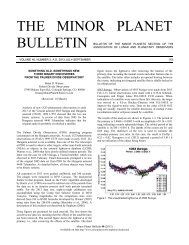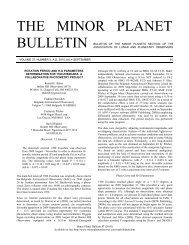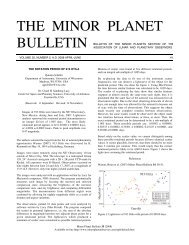THE MINOR PLANET BULLETIN - MinorPlanet.Info
THE MINOR PLANET BULLETIN - MinorPlanet.Info
THE MINOR PLANET BULLETIN - MinorPlanet.Info
- No tags were found...
You also want an ePaper? Increase the reach of your titles
YUMPU automatically turns print PDFs into web optimized ePapers that Google loves.
95<br />
contaminated our results. We then switched to using two stars of<br />
near solar color that were in the asteroid field. This, in turn, lead to<br />
new results of B-V = 0.84 ± 0.06 and V-R = 0.39 ± 0.02, which<br />
are in much better agreement with Hergentrother et al. Based on<br />
the V-R value, the apparent magnitude on 2007 April 1 at 01:04<br />
UT was V = 10.17 ± 0.02. This value agrees with the Minor Planet<br />
Center (MPC) ephemeredes to within 0.8%. This small difference<br />
could be justified partially by the G = 0.15 value used in the object<br />
magnitudes calculation. A two-color diagram using the B-V and<br />
V-R values suggests that 2006 VV2 may be of type V or Q (see<br />
Dandy et al., 2003). When using the Hergenrother et al. (2009)<br />
color indices and same method, 2006 VV2 may be classified as a<br />
T type.<br />
Assuming an average value of V-R = 0.42, we converted R<br />
magnitude values published in the MPC circulars (Casali et al.,<br />
2007, Helin et al., 2006) to V in order to find the absolute<br />
magnitude (H) and phase slope parameter (G) of the asteroid. The<br />
computed V magnitudes were entered into the H-G calculator in<br />
MPO Canopus, which uses the FAZ routine by Alan Harris. If the<br />
MPC default of G = 0.15 is used, the result is H = 16.5 ± 0.2. This<br />
is consistent with a value of H = 16.8 ± 0.5 reported on the JPL<br />
Small-Body Database Browser. If we use G = 0.36, the value for<br />
Vesta found by Hollis (2002), we find H = 16.7 ± 0.1. When both<br />
values are allowed to “float”, the results are H = 16.6 ± 0.2 and G<br />
= 0.2 ± 0.2 (Figure 1). From these, we estimate the diameter of<br />
2006 VV2 to be D = 1.06 ± 0.05 km when using the albedo for<br />
Vesta, p V = 0.36 (Hollis, 2002).<br />
2008 BT18. The binary nature of 2008 BT18 was reveled during<br />
radar observations on 2008 July 6 and 7 from the Arecibo<br />
observatory. The primary has a diameter of 600 meters and the<br />
secondary has a diameter of > 200 meters (Benner et al., 2008).<br />
Reddy et al (2008), based on a Near-IR spectrum from NASA<br />
IRTF, suggested a classification of type V and reported a synodic<br />
rotation period of 2.57h. We observed the asteroid on 2008 July<br />
24-26 UT, gathering 452 images of 30-s exposure in V filter. Each<br />
observation session had a typical duration of 4 hours. The short<br />
exposure times were necessary to keep the asteroid profile<br />
somewhat “stellar” despite its rapid sky motion. All images were<br />
corrected with bias, dark, and flat-field frames. The period search<br />
using Fourier series was performed using FALC routine of MPO<br />
Canopus. We found a synodic period of P = 2.726 ± 0.007 h with<br />
a lightcurve amplitude of A = 0.045 ± 0.002 mag (Figure 2). We<br />
tried to reduce the noise of the original data by binning three<br />
consecutive data points into one. This produced RMS = 0.04 mag,<br />
but the noise remained to be significant in relation to the total<br />
amplitude. Using V-R = 0.41, typical of V type asteroids (Dandy<br />
et al., 2003), we converted R magnitudes published in the MPC<br />
circulars (Young et al., 2008; Matson et al., 2008) to V<br />
magnitudes. This dataset was combined with our V magnitudes<br />
from July 24 and 26, phase angle > 30 o , to find H = 18.7 ± 0.3<br />
with G = 0.15. This just fits with the H = 18.2 ± 0.5 given in the<br />
JPL Small-Body Database Browser. If G is forced to 0.36, H =<br />
19.0 ± 0.2. If both values are allowed to “float”, we find H = 18.2<br />
± 0.2 and G = 0.2 ± 0.1 (Figure 3). If the last values are used, we<br />
calculate a diameter of D = 0.510 ± 0.05 km, which is in good<br />
agreement with the radar-derived diameter.<br />
Including no opposition effect in the calculations, the linear phase<br />
coefficient for 2006 VV2 and 2008 BT18 are estimated to be β =<br />
0.03 ± 0.01 and = 0.030 ± 0.005 mag/deg, respectively (Figure 4).<br />
The phase angle variation is nearly the same in both values. From<br />
this, we conclude that both asteroids have approximately the same<br />
linear coefficient and large-scale roughness. This roughness is<br />
probably similar to that of 2 Vesta (0.021 mag/deg; Rock and<br />
Hollis, 1990) or 2511 Patterson (0.028±0.001 mag/deg; Juarez et<br />
al., 2005), a Vesta family member.<br />
Acknowledgments<br />
Thanks to the Vitae Foundation, MCT, IFBA and the Institute of<br />
Physics of UFBA (IF-UFBA) for supporting the “Discovering the<br />
Sky” and “Astronomy in the Campus” projects.<br />
References<br />
Benner, L.A.M., Ostro, S.J., Giorgini, J.D., Busch, M.W.,<br />
Rose, R., Slade, M.A., Jurgens, R.F., Nolan, M.C., Hine, A.A.,<br />
Black, G.J., and Carter, L.M. (2007). “2006 VV2”. IAU Circ.<br />
8826, 3.<br />
Benner, L.A.M., Nolan, M.C., Howell, E.S., Magri, C.,<br />
Giorgini, J.D., Ostro, S.J., Brozovic, M., Busch, M.W.,<br />
Margot, J.L., Taylor, P.A., and 3 coauthors (2008). “2008 BT18”.<br />
CBET 1450, 1<br />
Betzler, A.S., Ferreira, D.H., Dos Santos, T.H.R., and<br />
Novaes, A.B. (2008). “Photometric Observations of 2006 VV2 in<br />
the State of Bahia-Brazil”. Minor Planet Bul. 35, 15-16.<br />
Casali, M., Marinello, W., Micheli, M., Pizzetti, G.,<br />
Soffiantini, A., Lopez, A., Pacheco, R., Buzzi, L., Luppi, F.,<br />
Young, J., and 27 coauthors. (2006). “2006 VV2”. MPEC 2006-<br />
V47.<br />
Dandy, C.L., Fitzsimmons, A., and Collander-Brown, S.J. (2003).<br />
“Optical colors of 56 near-Earth objects: trends with size and<br />
orbit”. Icarus 163, 363-373.<br />
Hergenrother, C.W., Whiteley, R.J., and Christensen, E.J. (2009).<br />
“Photometric Observations of Five Near-Earth Asteroids: (31221)<br />
1998 BP26, (96315) 1997 AP10, (164184) 2004 BF68, 2006 VV2,<br />
and 2006 XY”. Minor Planet Bul. 36, 16-18.<br />
Helin, E.F., Pravdo, S., Lawrence, K., Kuluhiwa, K., Hicks, M.,<br />
Matson, R., Sherrod, P.C., Birmingham, D. A., and<br />
Williams, G.V. (2006). “2006 VV2”. MPEC 2006-W87<br />
Hollis, A. J. (2002). “Observations of (4) Vesta between 1989 and<br />
1996”. JBAA 112, 86-88.<br />
Howell, E.S., Magri, C., Vervack, R.J., Nolan, M.C.,<br />
Fernandez, Y., and Rivkin, A.S. (2008). “Thermal Infrared<br />
Observations of Several Near-Earth Asteroids”. B.A.A.S. 40,<br />
#28.02.<br />
Juarez, R.A., Martinez, C.T., Ryan, W.H., and Ryan, E.V. (2005).<br />
“Physical Properties of the Vesta family asteroid 2511 Patterson”.<br />
B.A.A.S. 37, 1155.<br />
Matson, R., Bambery, R., Helin, E., Pravdo, S., Hicks, M.,<br />
Lawrence, K., Kervin, P., and Spahr, T.B. (2008). “2008 BT18”.<br />
MPEC 2008-H06.<br />
Reddy, V., Emery, J.P., and Gaffey, M.J. (2008). “Compositional<br />
Investigation of Binary Potentially-Hazardous Asteroid 2008<br />
BT 18 : A Basaltic Achondrite”. B.A.A.S. 40, #25.07.<br />
Minor Planet Bulletin 36 (2009)










